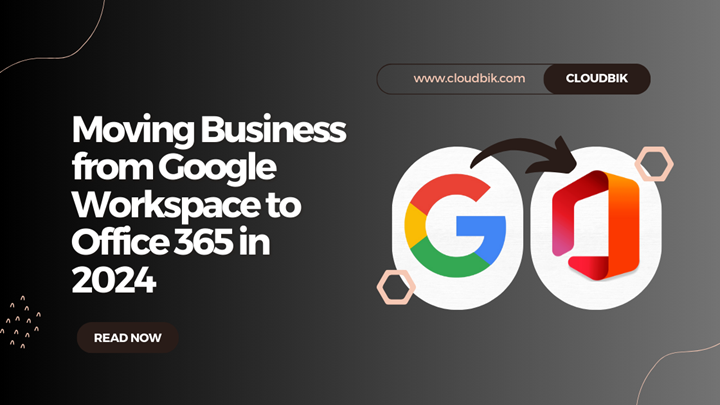As companies continue to prioritize efficient collaboration, productivity, and security, more are opting to transition from Google Workspace to Office 365. Equipped with versatile tools like Microsoft Teams, Outlook, and SharePoint, Office 365 delivers a comprehensive suite that fulfills the evolving demands of businesses in 2024. If you’re seeking improved integration or advanced security capabilities, migrating your business from Google Workspace to Office 365 can offer transformative benefits. In this guide, we will discuss the process, advantages, and important factors to ensure a smooth transition.
Why Migrate from Google Workspace to Office 365?
Before diving into the migration process, it’s essential to understand the reasons behind switching from Google Workspace to Office 365:
- Comprehensive Tools: Office 365 offers an integrated suite of apps like Word, Excel, PowerPoint, and Microsoft Teams, designed for collaboration and productivity. These tools work together seamlessly, making it easier to manage business workflows.
- Advanced Security: With increasing cyber threats, businesses are prioritizing security. Office 365 provides enhanced security measures like advanced threat protection, multi-factor authentication, and compliance tools to safeguard data.
- Improved Communication: Microsoft Teams has become a central hub for teamwork, offering chat, video conferencing, and file-sharing all in one place. For businesses, this means smoother internal communication and collaboration.
- Cost-Effectiveness: With flexible subscription models, Office 365 allows businesses to scale their services based on their needs, potentially saving on unnecessary expenses.
The Migration Process: Google Workspace to Office 365
Migrating from Google Workspace to Office 365 may seem daunting, but with the right steps and professional support, the process can be smooth. Here’s how you can approach it:
Assess Your Current Environment
Before starting the migration, conduct an in-depth analysis of your current Google Workspace setup. This includes:
- Identifying Users: List all users and their email addresses.
- Data Size: Calculate the size of emails, files, and documents that need to be migrated.
- Third-Party Integrations: Review any third-party apps connected to Google Workspace that need to be reconfigured or replaced in Office 365.
Plan Your Migration Strategy
Careful planning is essential for a smooth transition. Decide whether you’ll perform the migration in-house or hire email migration services for professional support. You’ll also need to choose the type of migration:
- Cutover Migration: Ideal for smaller businesses, this involves migrating all users at once.
- Staged Migration: For larger organizations, this process moves users in batches over time.
Set Up Office 365 Accounts
Next, set up Office 365 accounts for all your users. Depending on your subscription plan, ensure you’ve assigned the appropriate licenses to each employee. Users will need to log in to their new accounts and familiarize themselves with the Office 365 interface.
Migrate Emails and Files
This is the core step where email migration services can prove invaluable. These services use specialized tools to transfer emails, contacts, calendars, and documents from Google Workspace to Office 365 with minimal downtime.
For manual migration, you can use Microsoft’s built-in migration tools that are in the Migration Tab in Exchange Admin Center, depending on your data volume and complexity. For manual method, you can visit this guide on migrate from Google Workspace to Office 365 and learn how to perform the migration using native method for free.
Configure Domain and DNS Settings
After migrating, update your domain settings to point to Office 365’s mail servers. This ensures that all emails are routed to the new platform. You’ll need to update DNS records and verify your domain ownership within the Microsoft 365 admin center.
Train Your Employees
To maximize the benefits of Office 365, provide training sessions for your employees. Show them how to use apps like Outlook, Teams, and OneDrive, as well as any new features they didn’t have access to in Google Workspace.
Post-Migration Support and Monitoring
Once the migration is complete, monitor the performance of the new system closely. Provide support to employees facing any technical difficulties and resolve any post-migration issues promptly.
Benefits of Hiring Professional Email Migration Services
While some businesses may prefer to handle the migration internally, hiring professional email migration services can save time and reduce the risk of data loss. Here are a few reasons to consider outsourcing:
- Minimized Downtime: Professionals can ensure the transition happens swiftly with minimal disruption to your business operations.
- Data Integrity: Expert migration teams can handle complex tasks like transferring large volumes of data without losing any information.
- Advanced Security Measures: Email migration services can help ensure that all security settings are correctly configured in your new Office 365 environment, protecting your sensitive business data.
Conclusion
Migrating your business from Google Workspace to Office 365 in 2024 can significantly enhance your organization’s productivity, collaboration, and security. Whether you’re a small business or an enterprise, a smooth migration requires proper planning and possibly the assistance of email migration services. By following the steps outlined in this guide, you’ll ensure a successful transition and unlock the full potential of the Microsoft 365 ecosystem. Start your migration today and lead your business into the future with Office 365!
Read More: Importance of Competitor Research




